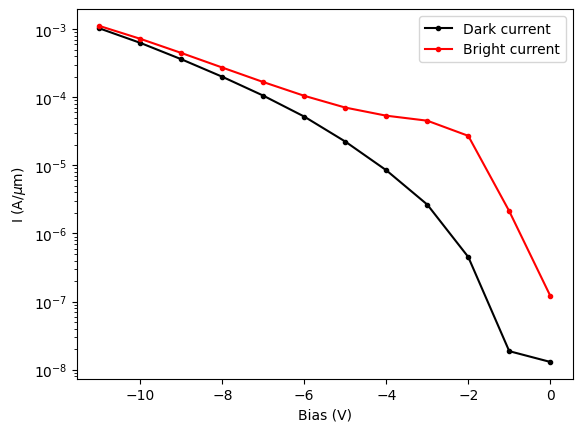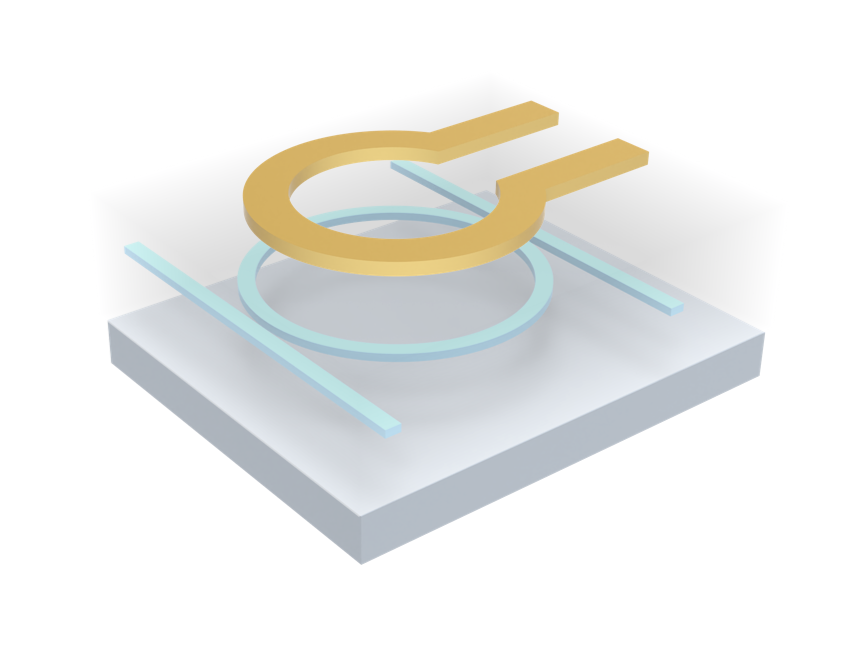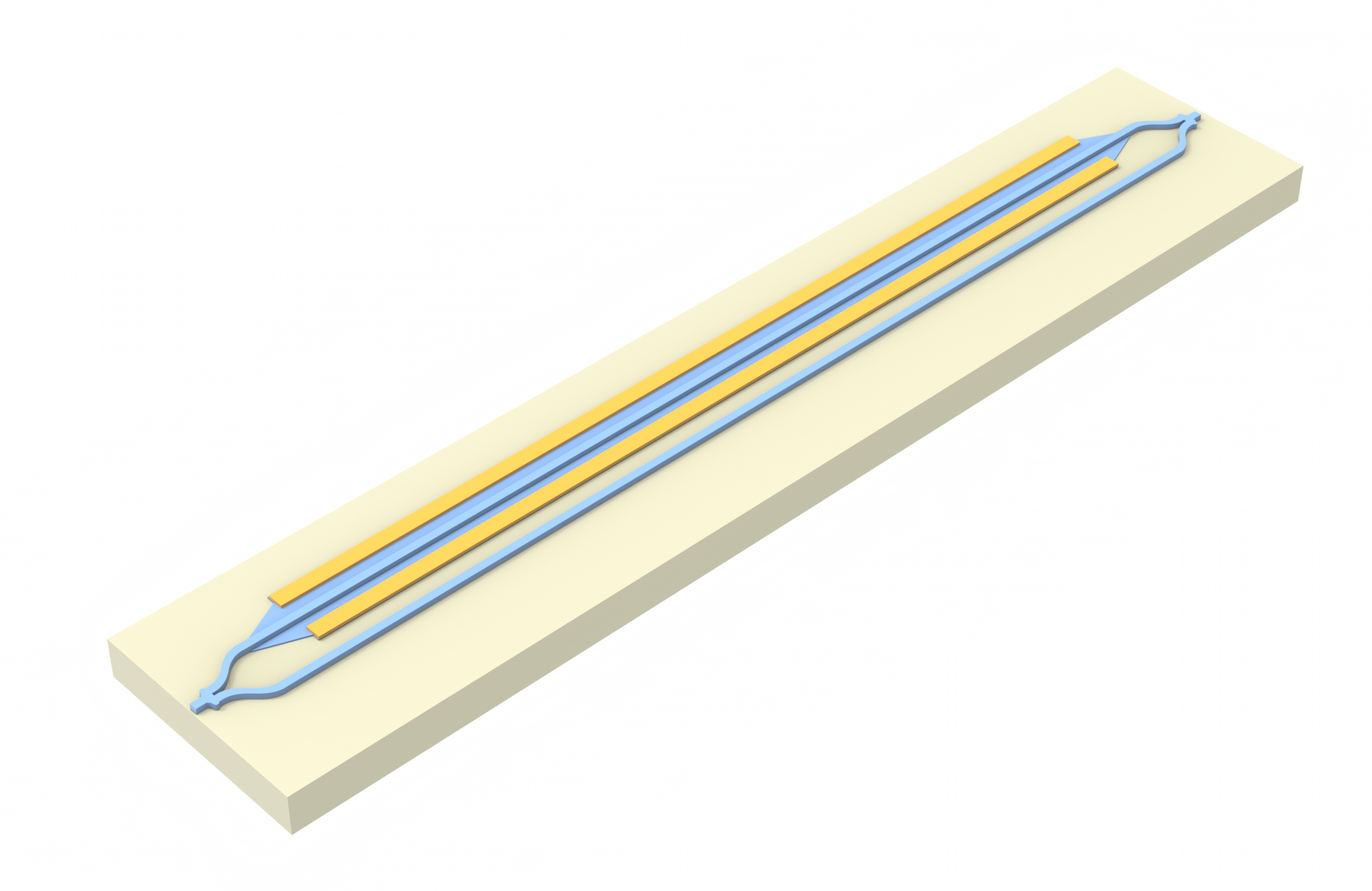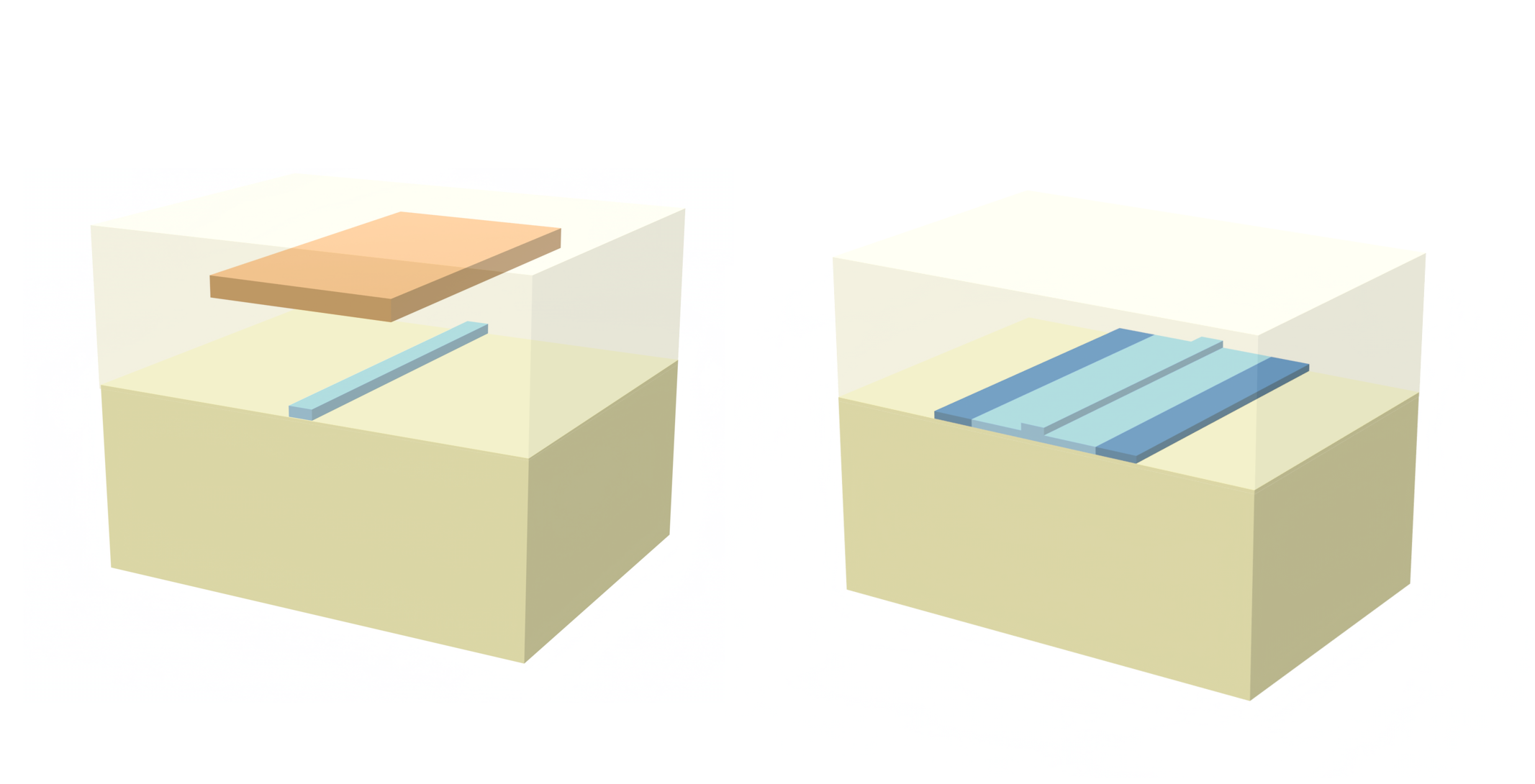This notebook demonstrates the modeling of an on-chip avalanche photodiode (APD). These photodetectors provide internal signal amplification by operating under high reverse bias and are used in many applications where it is necessary to detect very weak optical signals.
The internal gain in an APD arises from impact ionization, which occurs when the electric field is strong enough for charge carriers to gain sufficient kinetic energy to ionize atoms and create additional electron–hole pairs.
The device is inspired by the work of Zhihong Huang, Cheng Li, Di Liang, Kunzhi Yu, Charles Santori, Marco Fiorentino, Wayne Sorin, Samuel Palermo, and Raymond G. Beausoleil, "25 Gbps low-voltage waveguide Si–Ge avalanche photodiode," Optica 3(8), (2016). DOI: https://doi.org/10.1364/OPTICA.3.000793. It consists of a rib Si waveguide with n–p–i doping, the Ge region p- and pp-doped, and aluminum contacts.
The general workflow is as follows:
1. Define multiphysics media
We will define both the optical and charge properties of the materials, including doping, and models for band-to-band tunneling and impact ionization.
2. Run the optical simulation
We will use ModeSolver to calculate the waveguide modes.
3. Calculate optical absorption and carrier generation
With the field profile information, we will calculate the volumetric absorbed power:
$P_{abs} = \tfrac{1}{2} \, \omega \, \varepsilon_0 \, \varepsilon'' \, |E|^2$,
where $\varepsilon_0$ is the vacuum permittivity, and $\varepsilon''$ is the imaginary part of the complex permittivity.
Next, we compute the electron–hole pair generation rate:
$g = \tfrac{P_{abs}}{\hbar\omega q} \ \text{[1/(s µm}^3)]$
where $q$ is the electron charge.
4. Charge simulation
Finally, we will use the carrier generation data in a charge simulation to calculate the dark current and bright current.

import numpy as np
import tidy3d as td
from matplotlib import pyplot as plt
from tidy3d import web
# Prevent warning messages relevant only for FDTD simulations
td.config.logging_level = "ERROR"
Simulation Setup¶
First we define global parameters used in the simulation.
Since the structure is symmetric to x = 0. we're modeling only the right half of the device. With this in mind, width is the width of half of the component, i.e., the half being modeled.
# NOTE: all dimensions in um
z_size = 1
# si_bottom
si_b_w = 4.4 # width
si_b_h = 0.35 / 5 # height
# si_top
si_t_w = 2.2 # width
si_t_h = 0.35 * 4 / 5 # height
# Ge
ge_b_w = 1.8 # bottom width
ge_t_w = 1.15 # top width
ge_h = 0.35 # height
# SiO2 padding
sio2_w = si_b_w
sio2_h = 0.6
# emitter
emitter_w = 1 # width
emitter_h = 0.6 # height
# collector
collector_w = 0.5 # width
collector_h = 0.6 # height
total_h = 2 * sio2_h + si_b_h + si_t_h + ge_h
# Temperature (K)
T0 = 280
# structure overlap
s_ol = 1e-8
wvl_um = 1.55
freq0 = td.C_0 / wvl_um
P_in = 3e-4 # guided mode power [W]
Defining Media¶
Now, we will define the media for the multiphysics simulations.
The Si and Ge will be modeled with the SemiconductorMedium class.
To accurately simulate the APD behavior, we will add to the semiconductor media a band-to-band tunneling model, defined with the HurkxDirectBandToBandTunneling object, and an impact ionization model, defined with the SelberherrImpactIonization object.
intrinsic_si = td.SemiconductorMedium(
permittivity=11.7,
N_c=td.IsotropicEffectiveDOS(m_eff=1.18),
N_v=td.IsotropicEffectiveDOS(m_eff=0.8098),
E_g=td.VarshniEnergyBandGap(eg_0=1.16, alpha=4.73e-4, beta=636),
mobility_n=td.CaugheyThomasMobility(
mu_min=52.2,
mu=1471.0,
ref_N=9.68e16,
exp_N=0.68,
exp_1=-0.57,
exp_2=-2.33,
exp_3=2.4,
exp_4=-0.146,
),
mobility_p=td.CaugheyThomasMobility(
mu_min=44.9,
mu=470.5,
ref_N=2.23e17,
exp_N=0.719,
exp_1=-0.57,
exp_2=-2.33,
exp_3=2.4,
exp_4=-0.146,
),
R=[
td.ShockleyReedHallRecombination(
tau_n=td.FossumCarrierLifetime(
tau_300=1e-12, alpha_T=0, A=1, B=0, C=1, N0=7.1e15, alpha=1
),
tau_p=td.FossumCarrierLifetime(
tau_300=1e-12, alpha_T=0, A=1, B=0, C=0, N0=7.1e15, alpha=1
),
),
td.RadiativeRecombination(r_const=1.6e-14),
td.AugerRecombination(c_n=2.8e-31, c_p=9.9e-32),
td.HurkxDirectBandToBandTunneling(A=4e14, B=1.9e6, sigma=2.5),
td.SelberherrImpactIonization(
alpha_n_inf=7.03e5,
alpha_p_inf=1.582e6,
E_n_crit=1.23e6,
E_p_crit=2.03e6,
beta_n=1,
beta_p=1,
),
],
delta_E_g=td.SlotboomBandGapNarrowing(
v1=9 * 1e-3,
n2=1e17,
c2=0.5,
min_N=1e15,
),
)
intrinsic_ge = td.SemiconductorMedium(
permittivity=16,
N_c=td.IsotropicEffectiveDOS(m_eff=0.56),
N_v=td.IsotropicEffectiveDOS(m_eff=0.29),
E_g=td.VarshniEnergyBandGap(eg_0=0.7437, alpha=0.0004774, beta=235),
mobility_n=td.CaugheyThomasMobility(
mu_min=850,
mu=3900,
ref_N=2.6e17,
exp_N=0.56,
exp_1=0,
exp_2=-1.66,
exp_3=0,
exp_4=0,
),
mobility_p=td.CaugheyThomasMobility(
mu_min=300,
mu=1800,
ref_N=1e17,
exp_N=1,
exp_1=0,
exp_2=-2.33,
exp_3=0,
exp_4=0,
),
R=[
td.ShockleyReedHallRecombination(
tau_n=td.FossumCarrierLifetime(
tau_300=1e-10, alpha_T=0, A=1, B=0, C=0, N0=1e16, alpha=1
),
tau_p=td.FossumCarrierLifetime(
tau_300=1e-10, alpha_T=0, A=1, B=0, C=0, N0=1e16, alpha=1
),
),
td.RadiativeRecombination(r_const=6.41e-14),
td.AugerRecombination(c_n=1e-30, c_p=1e-30),
td.HurkxDirectBandToBandTunneling(A=9.1e16, B=4.9e6, E_0=1, sigma=2.5),
td.SelberherrImpactIonization(
alpha_n_inf=4.9e5,
alpha_p_inf=2.15e5,
E_n_crit=7.9e5,
E_p_crit=7.1e5,
beta_n=1,
beta_p=1,
),
],
delta_E_g=None,
)
Doping¶
Next, we will define the doping regions for both Si and Ge. We will use a GaussianDoping object, which creates a Gaussian doping distribution that better reflects real doping profiles.
n_Si = td.GaussianDoping.from_bounds(
concentration=1e19,
rmin=(-si_b_w, 0 - s_ol, -z_size),
rmax=(si_b_w, 0.22, z_size),
ref_con=1e16,
width=0.05,
source="ymin",
)
bg_Si = td.ConstantDoping.from_bounds(
concentration=1e16, rmin=(-si_b_w, 0, -z_size), rmax=(si_b_w, si_b_h + si_t_h + s_ol, z_size)
)
p_Si = td.ConstantDoping.from_bounds(
concentration=2e17,
rmin=(-si_b_w, si_b_h + si_t_h - 0.05, -z_size),
rmax=(si_b_w, si_b_h + si_t_h + s_ol, z_size),
)
p_Ge = td.GaussianDoping.from_bounds(
rmin=(-ge_b_w, si_b_h + si_t_h, -z_size),
rmax=(ge_b_w, si_b_h + si_t_h + ge_h, z_size),
ref_con=1e17,
concentration=1e18,
width=0.35,
source="ymax",
)
pp_Ge = td.GaussianDoping.from_bounds(
rmin=(-ge_b_w, si_b_h + si_t_h + ge_h - 0.02 - 0.02, -z_size),
rmax=(1.8, si_b_h + si_t_h + ge_h, z_size),
ref_con=1e16,
concentration=2e19,
width=0.02,
source="ymax",
)
doped_Si = intrinsic_si.updated_copy(N_a=[bg_Si, p_Si], N_d=[n_Si])
doped_Ge = intrinsic_ge.updated_copy(N_a=[p_Ge, pp_Ge])
Defining the Multiphysics Medium¶
Finally, we can combine the optical and charge material properties into a MultiPhysicsMedium.
doped_Si = intrinsic_si.updated_copy(N_a=[bg_Si, p_Si], N_d=[n_Si])
doped_Ge = intrinsic_ge.updated_copy(N_a=[p_Ge, pp_Ge])
Si = td.MultiPhysicsMedium(
charge=doped_Si,
optical=td.material_library["cSi"]["Palik_Lossless"],
name="Si",
)
Ge = td.MultiPhysicsMedium(
charge=doped_Ge,
optical=td.material_library["Ge"]["Nunley"],
name="Ge",
)
SiO2 = td.MultiPhysicsMedium(
charge=td.ChargeInsulatorMedium(permittivity=3.9),
optical=td.material_library["SiO2"]["Horiba"],
name="SiO2",
)
Al = td.MultiPhysicsMedium(
charge=td.ChargeConductorMedium(conductivity=1),
optical=td.material_library["Al"]["RakicLorentzDrude1998"],
name="Al",
)
si_bottom = td.Structure(
geometry=td.Box.from_bounds(rmin=(-si_b_w, 0, -z_size), rmax=(si_b_w, si_b_h, z_size)),
medium=Si,
name="si_bottom",
)
si_top = td.Structure(
geometry=td.Box.from_bounds(
rmin=(-si_t_w, si_b_h - s_ol, -z_size), rmax=(si_t_w, si_b_h + si_t_h + s_ol, z_size)
),
medium=Si,
name="si_top",
)
vertices = np.array(
[
(-ge_b_w, si_b_h + si_t_h),
(ge_b_w, si_b_h + si_t_h),
(ge_t_w, si_b_h + si_t_h + ge_h),
(-ge_t_w, si_b_h + si_t_h + ge_h),
]
)
ge_struct = td.Structure(
geometry=td.PolySlab(vertices=vertices, axis=2, slab_bounds=(-z_size, z_size)),
medium=Ge,
name="ge_struct",
)
sio2_struct = td.Structure(
geometry=td.Box.from_bounds(
rmin=(-sio2_w, -sio2_h, -z_size), rmax=(sio2_w, si_b_h + si_t_h + ge_h + sio2_h, z_size)
),
medium=SiO2,
name="sio2_struct",
)
emitter = td.Structure(
geometry=td.Box.from_bounds(
rmin=(si_b_w - emitter_w, si_b_h - s_ol, -z_size), rmax=(si_b_w, si_b_h + emitter_h, z_size)
),
medium=Al,
name="emitter",
)
collector = td.Structure(
geometry=td.Box.from_bounds(
rmin=(-collector_w, si_b_h + si_t_h + ge_h - s_ol, -z_size),
rmax=(collector_w, si_b_h + si_t_h + ge_h + collector_h, z_size),
),
medium=Al,
name="collector",
)
structures = [sio2_struct, si_bottom, si_top, ge_struct, emitter, collector]
For easier communication between the optical and charge solvers, we can create a Scene object containing all the structures and the background medium.
scene = td.Scene(
structures=structures,
medium=td.MultiPhysicsMedium(heat=td.FluidMedium()),
)
_, ax = plt.subplots(1, 2, figsize=(10, 10))
scene.plot(z=0, ax=ax[0])
scene.plot_structures_property(z=0, property="doping", ax=ax[1])
plt.show()

Optical Simulation¶
Optical Structures¶
Since the mode solver doesn't yet support MultiPhysicsMedium, we'll recreate these structures using only their optical properties.
opt_structs = [struct.updated_copy(medium=struct.medium.optical) for struct in structures]
Defining the ModeSolver Object¶
Now, we will create a ModeSolver object to run mode analysis and obtain field data. We will also add a PermittivityMonitor to calculate the optical absorption and generation rate.
# Permittivity monitor
perm_mnt = td.PermittivityMonitor(
size=(2 * si_b_w, total_h, 0),
freqs=[freq0],
name="permittivity",
)
# Cross-section simulation (x-size=0), periodic bc OK for mode extraction
opt_grid = td.GridSpec.auto(min_steps_per_wvl=30, wavelength=wvl_um)
opt_sim = td.Simulation(
size=(2 * si_b_w, total_h, 0),
center=(0, total_h / 2 - sio2_h / 2, 0),
structures=opt_structs,
medium=SiO2.optical,
run_time=1e-15,
grid_spec=opt_grid,
boundary_spec=td.BoundarySpec.all_sides(td.Periodic()),
)
# Mode plane through the core
from tidy3d.plugins.mode import ModeSolver
from tidy3d.plugins.mode.web import run as run_mode
mode_plane = td.Box.from_bounds(
rmin=(-si_b_w, -sio2_h, 0), rmax=(si_b_w, si_b_h + si_t_h + ge_h + 1, 0)
)
ms = td.ModeSimulation.from_simulation(
simulation=opt_sim,
plane=mode_plane,
mode_spec=td.ModeSpec(num_modes=1),
freqs=[freq0],
colocate=False,
fields=["Ex", "Ey", "Ez"],
monitors=[perm_mnt],
)
ms.plot()
plt.show()

Running the mode solver.
mode_data = web.run(ms, task_name="APD_opt")
18:09:20 -03 Created task 'APD_opt' with resource_id 'mos-5e6d2c3c-c26e-47b8-b94f-6cc3b99665db' and task_type 'MODE'.
Output()
18:09:29 -03 Estimated FlexCredit cost: 0.007. Minimum cost depends on task execution details. Use 'web.real_cost(task_id)' to get the billed FlexCredit cost after a simulation run.
18:09:31 -03 status = success
Output()
18:09:38 -03 Loading simulation from simulation_data.hdf5
Mode Solver Results¶
First, we can visualize the field profiles.
# Visualize mode fields (Ex, Ey, Ez) and report n_eff
fig, ax = plt.subplots(1, 3, figsize=(12, 3))
mode_data.plot_field(field_name="Ex", ax=ax[0])
ax[0].set_title("Ex")
mode_data.plot_field(field_name="Ey", ax=ax[1])
ax[1].set_title("Ey")
mode_data.plot_field(field_name="Ez", ax=ax[2])
ax[2].set_title("Ez")
plt.tight_layout()
print("n_eff:", float(mode_data.modes.n_eff.isel(f=0, mode_index=0)))
plt.show()
n_eff: 4.338929562235545

Generation Rate Calculation¶
Optical Absorption Calculation¶
Now, we will calculate the optical absorption, defined as:
$$P_{abs} = \tfrac{1}{2} \, \omega \, \varepsilon_0 \, \varepsilon'' \, |E|^2$$
We will normalize the power to a scale factor $P_{in}$ of 30 mW, which is a common value for Si photonics.
# Extract mode fields and scale to target optical power P_in
Ex = mode_data.modes.Ex.isel(f=0, mode_index=0)
Ey = mode_data.modes.Ey.isel(f=0, mode_index=0)
Ez = mode_data.modes.Ez.isel(f=0, mode_index=0)
scale = np.sqrt(P_in)
Ex_s = Ex * scale
Ey_s = Ey * scale
Ez_s = Ez * scale
# Use xy plane boundaries (fields are not colocated)
x = Ex.coords["x"][1:-1]
y = Ex.coords["y"][1:-1]
# Extract permittivity values
eps_xx = mode_data["permittivity"].eps_xx.isel(f=0)
eps_yy = mode_data["permittivity"].eps_yy.isel(f=0)
eps_zz = mode_data["permittivity"].eps_zz.isel(f=0)
# Calculate the squared magnitude for each E-field component.
E_squared_magnitude_x = Ex_s * Ex_s.conj()
E_squared_magnitude_y = Ey_s * Ey_s.conj()
E_squared_magnitude_z = Ez_s * Ez_s.conj()
kwargs = {"fill_value": 0}
Power_density_E_x = np.pi * freq0 * td.EPSILON_0 * eps_xx.imag * E_squared_magnitude_x
Power_density_E_y = np.pi * freq0 * td.EPSILON_0 * eps_yy.imag * E_squared_magnitude_y
Power_density_E_z = np.pi * freq0 * td.EPSILON_0 * eps_zz.imag * E_squared_magnitude_z
Power_density_E = (
Power_density_E_x.interp(x=x, y=y, kwargs=kwargs)
+ Power_density_E_y.interp(x=x, y=y, kwargs=kwargs)
+ Power_density_E_z.interp(x=x, y=y, kwargs=kwargs)
).real
print("Integrated power density:", float(Power_density_E.integrate(coord=["x", "y"])))
Integrated power density: 0.0001791077796829375
Next, we can calculate the pair generation rate by dividing the power density by the photon energy and the electron charge, assuming a quantum efficiency of 1.
$$g = \tfrac{P_{abs}}{\hbar\omega q} \ \text{[1/(s µm}^3)]$$
# Photon energy in eV
Eph = 2 * np.pi * td.HBAR * td.C_0 / wvl_um
# Assuming single optical frequency and a quantum efficiency of 1
g = Power_density_E / (Eph * td.Q_e)
# Visualize the generation rate
ax = np.log10(g.clip(0).T).plot(vmin=0).axes
ax.set_aspect("equal")
plt.show()
/home/filipe/anaconda3/envs/develop/lib/python3.11/site-packages/xarray/computation/apply_ufunc.py:818: RuntimeWarning: divide by zero encountered in log10 result_data = func(*input_data)

Charge Simulation¶
Now, we can create a HeatChargeSimulation object to perform a charge simulation and calculate the generated currents.
First, we will run a simulation without applying the previously calculated generation rate in order to obtain the dark current, which is the current that flows under a given reverse bias in the absence of illumination, originating from thermally generated carriers and tunneling processes.
Next, we will simulate the device including the generation rate produced by incident light. This yields the bright current, which is the useful photocurrent to be measured. The larger the difference between bright current and dark current (or more precisely, the larger the photocurrent relative to the noise associated with the dark current), the higher the APD sensitivity.
First, we define the voltage boundary conditions for the applied bias.
voltages = np.linspace(-11, 0, 12).tolist()
emitter_bc = td.HeatChargeBoundarySpec(
placement=td.StructureStructureInterface(structures=[emitter.name, si_bottom.name]),
condition=td.VoltageBC(source=td.DCVoltageSource(voltage=0)),
)
collector_bc = td.HeatChargeBoundarySpec(
placement=td.StructureStructureInterface(structures=[ge_struct.name, collector.name]),
condition=td.VoltageBC(source=td.DCVoltageSource(voltage=voltages)),
)
bcs = [emitter_bc, collector_bc]
Next, we define the carrier, potential, and steady-state current density monitors.
carrier_mnt = td.SteadyFreeCarrierMonitor(
size=(td.inf, td.inf, td.inf), unstructured=True, name="carrier_mnt"
)
potential_mnt = td.SteadyPotentialMonitor(
size=(td.inf, td.inf, td.inf), unstructured=True, name="potential_mnt"
)
j_mnt = td.SteadyCurrentDensityMonitor(
size=(td.inf, td.inf, td.inf), unstructured=True, name="j_mnt"
)
monitors = [carrier_mnt, potential_mnt, j_mnt]
Mesh¶
We define a DistanceUnstructuredGrid mesh, using GridRefinementLine objects to refine the grid at the collector–Ge, Si–Ge, and Si n–Si p interfaces.
collector_ref = td.GridRefinementLine(
r1=(0, si_b_h + si_t_h + ge_h - 0.02, 0),
r2=(ge_t_w, si_b_h + si_t_h + ge_h - 0.02, 0),
dl_near=0.02 / 5,
distance_near=0.02,
distance_bulk=2 * 0.02,
)
ge_si_ref = td.GridRefinementLine(
r1=(0, si_b_h + si_t_h, 0),
r2=(ge_b_w, si_b_h + si_t_h, 0),
dl_near=0.02 / 5,
distance_near=0.02,
distance_bulk=2 * 0.02,
)
si_b_h + 0.07
npp_doping_ref = td.GridRefinementLine(
r1=(0, 0.22, 0),
r2=(si_t_w, 0.22, 0),
dl_near=0.02 / 5,
distance_near=0.02,
distance_bulk=2 * 0.02,
)
mesh_spec = td.DistanceUnstructuredGrid(
dl_interface=si_b_h / 8,
dl_bulk=si_b_h,
distance_interface=si_b_h / 2,
distance_bulk=si_b_h,
relative_min_dl=0,
sampling=500,
uniform_grid_mediums=[Si.name, Ge.name],
mesh_refinements=[collector_ref, ge_si_ref, npp_doping_ref],
)
Tolerances and Analysis Type¶
Next, we define the tolerance settings and set the analysis type to IsothermalSteadyChargeDCAnalysis.
convergence_settings = td.ChargeToleranceSpec(
rel_tol=1e2, abs_tol=1e12, max_iters=100, ramp_up_iters=2
)
analysis_type = td.IsothermalSteadyChargeDCAnalysis(
temperature=T0, convergence_dv=12, tolerance_settings=convergence_settings, fermi_dirac=True
)
Finally, we can create the HeatChargeSimulation object for the Scene object.
sim = td.HeatChargeSimulation.from_scene(
scene=scene,
size=(si_b_w, total_h, 0),
center=(si_b_w / 2, total_h / 2 - sio2_h / 2, 0),
monitors=monitors,
grid_spec=mesh_spec,
boundary_spec=bcs,
analysis_spec=analysis_type,
)
sim.plot_property(z=0, property="electric_conductivity")
plt.show()
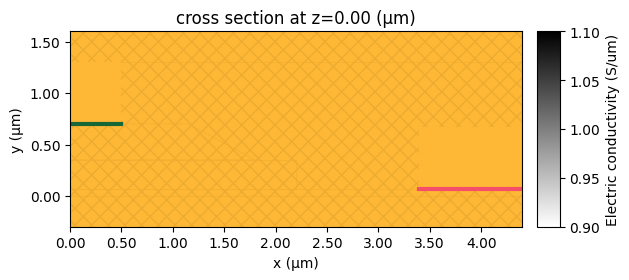
Run Charge Dark Simulation¶
Now, we can run the simulation to calculate the dark current generated without incident light.
results = web.run(sim, task_name="APD_charge")
18:09:41 -03 Created task 'APD_charge' with resource_id 'hec-a75ca123-a125-4a20-967f-f53c0f333268' and task_type 'HEAT_CHARGE'.
Tidy3D's HeatCharge solver is currently in the beta stage. Cost of HeatCharge simulations is subject to change in the future.
Output()
18:09:51 -03 Estimated FlexCredit cost: 0.025. Minimum cost depends on task execution details. Use 'web.real_cost(task_id)' to get the billed FlexCredit cost after a simulation run.
18:09:54 -03 status = success
Output()
18:10:19 -03 Loading simulation from simulation_data.hdf5
# Visualize the x component of the electric current density
results[j_mnt.name].J.sel(z=0, voltage=-10, method="nearest").sel(axis=0).plot(
grid=False, vmin=-0.015, vmax=0
)
plt.show()

# Plot the dark current
I = abs(results.device_characteristics.steady_dc_current_voltage)
fig, ax = plt.subplots()
ax.plot(I.v, I, marker="*")
ax.set_ylabel(r"I (A/$\mu$m)")
ax.set_xlabel("Applied bias (V)")
ax.set_yscale("log")
plt.show()

Photocurrent Simulation¶
Next, we update our semiconductor media with a DistributedGeneration object, using from_rate_um3, where we input the calculated generation rate.
# Apply generation rate to semiconductor materials
charge_structs = []
for struct in structures:
if isinstance(struct.medium.charge, td.SemiconductorMedium):
sc = struct.medium
R = list(sc.charge.R)
R.append(td.DistributedGeneration.from_rate_um3(gen_um3=g))
sc = sc.updated_copy(charge=sc.charge.updated_copy(R=R))
charge_structs.append(struct.updated_copy(medium=sc))
else:
charge_structs.append(struct)
scene = scene.updated_copy(structures=charge_structs)
sim_with_g = td.HeatChargeSimulation.from_scene(
scene=scene,
size=(si_b_w, total_h, 0),
center=(si_b_w / 2, total_h / 2 - sio2_h / 2, 0),
monitors=monitors,
grid_spec=mesh_spec,
boundary_spec=bcs,
analysis_spec=analysis_type,
)
Run Bright Simulation¶
results_with_g = web.run(sim_with_g, task_name="APD_charge")
18:10:20 -03 Created task 'APD_charge' with resource_id 'hec-2cd44243-168e-4a60-971b-444fc76bdf8a' and task_type 'HEAT_CHARGE'.
Tidy3D's HeatCharge solver is currently in the beta stage. Cost of HeatCharge simulations is subject to change in the future.
Output()
18:10:37 -03 Estimated FlexCredit cost: 0.025. Minimum cost depends on task execution details. Use 'web.real_cost(task_id)' to get the billed FlexCredit cost after a simulation run.
18:10:39 -03 status = success
Output()
18:11:08 -03 Loading simulation from simulation_data.hdf5
Finally, we plot the dark and bright currents together.
Over the whole bias range, the bright current remains higher than the dark current, and both increase monotonically with reverse bias. Around −2 V we observe the unity-gain operating point, where the onset of impact ionization occurs, consistent with the value reported in the paper.
I_dark = abs(results.device_characteristics.steady_dc_current_voltage.data)
I = abs(results_with_g.device_characteristics.steady_dc_current_voltage.data)
V = results.device_characteristics.steady_dc_current_voltage.coords["v"]
plt.semilogy(V, I_dark, "k.-", label="Dark current")
plt.semilogy(V, I, "r.-", label="Bright current")
plt.legend()
plt.xlabel("Bias (V)")
plt.ylabel(r"I (A/$\mu$m)") # Label for y-axis
plt.show()
